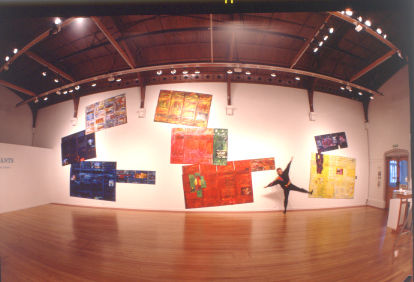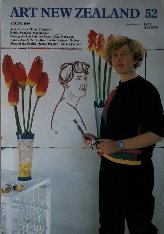|
|
    |
|
|
|
|

|
Jane Zusters is a teller
of stories, often veiled in metaphor and camouflaged with ambiguities,
but always deriving from her own relationships with people,
places and events.
In the 80s a need to communicate more with paint than abstract
theory and purely aesthetic values motivated the Italian artists
of the Transavante-gardia. (1) Zusters was initially exposed
to these postmodern, Neo-Expressionist works during her first
visit to Italy in 1984. The vital manner in which they portrayed
personal concerns about the human condition has remained an
important influence on her own practice. Traces of Cubism, Expressionism,
and Surrealism float to the surface in the Transavante-gardists'
melting pot, along with elements from Renaissance art and classical
antiquity. Like the Transavante-gardia, Zusters' work references
the continuum of western culture, the accumulative layering
of generations over centuries and the constant process of adaption
and revision of the past to meet the needs of today.
The symbol of a small rowboat with its connotation of journeys
and rites of passage is one of Zusters' frequently used motifs.
She has drawn, painted, scraffittied, photographed, collaged
and constructed boats for nearly three decades. Like the clinker
dinghy in her painting Vada Italia, her winning entry in the
1984 Montana Art Award, they represent physical as well as intellectual
or spiritual journeys. The title, the Italian translation of
'Italy I am Going', proved to be prophetic when Zusters used
the prize money to finance her first trip to Italy. The experience
was transforming, opening her eyes to the past and empowering
her with the means to express her vision with contemporary originality.
Her painting Renaissance Refuge won the Tokoroa Art Award in
1988, enabling her to revisit Italy and visit Etruscian tombs
and Giotto's fresco cycle of the life of Saint Francis of Assisi.
(2) An exhibition of contemporary Italian art proved to be revelatory.
Mimmo Paladino's success in 'establishing connections between
disparate elements' (3) a modernist, colour field painting
combined with a primitive face on an oval shaped painting and
an iron cart covered with small bronze busts provided confirmation
for Zusters' own recent experiments.
Once back in her Waiheke Island studio she began following the
example of the Transavante-gardists. She had tentatively been
adding painted images cut out of plywood to the surface of her
canvasses and now felt encouraged to combine photographs and
other material liberating her work from the confines of the
flat-framed rectangle.
Taking Giotto as her model, she sought to convey personal narratives
within her contemporary art practice, using elements of the
past as tools for the present. The construction paintings of
canvas, acrylic and plywood in the late '80s developed in the
'90s into luminous oils which were often painted on rimu ovals,
headboards or combined with timber found objects.
Her responses to the wider western cultural heritage have always
been mediated as a twentieth century artist from the other side
of the world. By the late 1990s Zusters was drawing the majority
of her subject matter from visual memories of life in the Southern
Hemisphere. Cook's Observed Latitude (Black and Blue Art Cross,
1999) conveys notions of distance in time and space. The dark
ovals within the arms of a 'Southern Cross' suggest separated
worlds divided by vast oceans alluding to cultural as much as
physical disconnection of the post-colonial.
Zusters encoded abstracting imbues her art with an intriguing,
enigmatic quality. The works revealing meaning over time, provoking
reflection and personal interpretation of the images.
Mark Hutchins, Wellington, 11/02/03
(1) Transavantgardia; Sandro Chia, Francesco Clemente, Enzo
Cucchi: a contemporary Italian school of postmodernism who drew
inspiration for their multimedia works from historical and contemporary
art
(2) Giotto: Fresco cycle on the life of his contemporary St
Francis, Upper Chappel, Assisi, 1290
(3) Zusters: conversation with the author, May 1998
|

Containants 1990, McDougall Art Gallery
Annex, Christchurch
|
 |
Jane Zusters was born in Christchurch, New
Zealand, in 1951. In 1973 she finished a BA in English and
was working as a teacher at Navua High School in Fiji, when
she decided to be an artist instead. She has spent her adult
life painting and taking photographs. She studied at the Canterbury
University School of Fine Arts for two years and in 1975,
while still a second year painting student, exhibited her
photographs in the "Six Women Artists" show curated by Allie
Eagle at the McDougall Art Gallery in Christchurch, NZ. In
1978 she was awarded a major Queen Elizabeth II Arts Council
Grant and moved to Auckland. In 2003 Jane completed
an MFA (First Class Honours) in photography at Whitecliffe
College of Art and Design.
Highlights for Jane have been winning first
prize in the Montana Art Award 1984, another Arts Council
Grant in 1986, winning first prize in the Tokoroa Art Award
in 1988 and being a joint winner of the Lilian Ida Smith Award
in 1994. Important experiences for Jane have been visiting
Italy in 1984 and again in 1988, being the Rita Angus Art
Trust artist in residence in 1991, and visiting Berlin on
a Goethe Institute Scholarship in 1992. In 1986 she had a
studio home built on Waiheke Island and she has done much
voyaging from there since. In 1999-2000 she lived in London for 10 months. At present she is living in Christchurch.
Jane Zusters is an experienced art tutor
who has facilitated numerous painting workshops, including
classes at Artstation, Auckland University Extension Studies,
E.I.T. Taradale Hawkes Bay and Wanganui Polytechnic. She was
a guest artist in residence at Canterbury University in 1995. In 2004 she was the William Hodges Fellow in Southland.
Jane Zusters is a painter and photographer who has recently moved into the areas of installation and DVD. In 2001 her art practice underwent a fundamental change when she was invited by Miranda Playfair to be part of Xerart, artists explore digital technology at the ASA gallery in Auckland. The ensuring exhibition 'Stratum' comprised work by Billy Apple, Carole Shepheard, Martin Ball, Harvey Benge, Stephen Lovett, Miranda Playfair (working as Girlie Pics) and Jane Zusters. Her show at Te tuhi - the mark in 2004 comprised found objects, painting and DVD. In 2004 she was the William Hodges fellow in Southland. Zusters most recent exhibition was at Pataka in 2005 and used the device of creating a 70s lounge to look at albums of photographs shown in conjunction with a continuously looped 20 min DVD. |
| Selected Bibliography
Dunn, Michael: Contemporary
Painting in New Zealand, 1996
Brown, Warwick: 100
New Zealand Paintings, 1995
Kirker, Anne: New
Zealand Women Artists: an update, 1992
Dunn, Michael: A
Concise History of New Zealand Painting, 1991
Dunn, Michael: Painting
since 1970: Update to 200 years of New Zealand Paintings,
1990
Spiral group: A Women's
Picture Book, 1988
Where to find Jane's Work
Jane's work is in numerous
public and private collections in New Zealand including Te
Papa - the National Art Gallery, Victoria University, Robert
McDougall Art Gallery, Canterbury University, Lincoln University,
College House, Waikato Art Museum, Suter Gallery, Manawatu
Art Gallery and Auckland University.
She has had 32 solo exhibitions
and been included in numerous group exhibitions during the
course of her art life. "I have spent my life as an art voyager,
refusing to be confined by one medium or a signature style."
Jane's paintings can
be seen at:
Campbell Grant Galleries,
191 Tuam St, Christchurch, NZ.
PO Box 22 474 Christchurch. Phone: 64 3 365-8300.
|
|
|